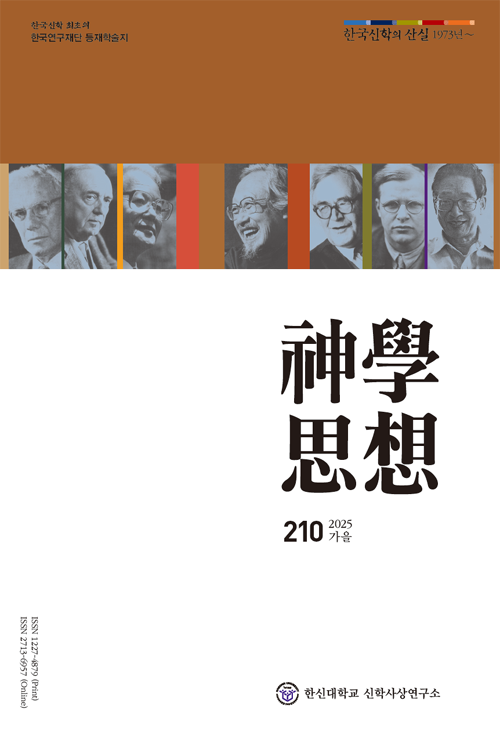- 영문명
- Neurohumanities of Disgust : Beyond Disgust to Compassion
- 발행기관
- 한신대학교 신학사상연구소
- 저자명
- 김성호(Sung-Ho Kim)
- 간행물 정보
- 『신학사상』210집(2025년 가을호), 253~296쪽, 전체 44쪽
- 주제분류
- 인문학 > 기독교신학
- 파일형태
- 발행일자
- 2025.09.30
8,080원
구매일시로부터 72시간 이내에 다운로드 가능합니다.
이 학술논문 정보는 (주)교보문고와 각 발행기관 사이에 저작물 이용 계약이 체결된 것으로, 교보문고를 통해 제공되고 있습니다.

국문 초록
우리는 왜 타자의 타자성과 차이, 타자의 고통에 무관심하면서 타자를 혐오하고 배제하며 차별하면서 살아갈까. 이런 문제 의식을 가지고 필자는 Ⅱ장에서 혐오의 정의와 혐오 대상을 다루었다. 필자는 혐오를 이질적 타자를 싫어하고 근접하기를 꺼리거나 기피하고 멀리하며 거부하는 감정으로 정의하고 다양한 혐오 대상을 언급했다. Ⅲ장에서는 혐오에 대한 진화론적, 신경생물학적 이해를 살펴보았다. 필자는 혐오에 대한 진화론적 입장이 오염원으로부터 자기를 보호하는 긍정적 의미가 있지만, 근거 없이 사회문화적 차원으로 무차별 확장하는 것은 위험하다고 지적했다. 또한 혐오는 인간의 개념이므로 혐오를 담당하는 뇌 영역이나 영역들의 집합을 찾는 것은 어불성설이고, 혐오 자극에 반응하는 뇌 부위를 제거한다 해도 우리가 혐오를 제거한다고 말할 수 없으며, 뇌가 경험과 환경에 따라 변하므로 우리의 자동화된 뇌 반응도 바꿀 수 있다고 지적했다. Ⅳ장에서는 아우렐 콜나이의 혐오에 대한 현상학적 이해를 살펴보았다. 콜나이는 혐오 현상을 부정하지 않았다. 그러나 그는 혐오를 정밀 조사하고 조명의 대상으로 삼아야 한다는 전제 아래 사랑을 통해 혐오가 극복될 수 있을 것이라고 어렵게 전망했다. 마지막으로 Ⅴ장에서는 혐오에 대한 대안으로 연민을 제시했다. 그리고 아리스토텔레스의 연민 정의를 해석하면서 연민에 필수적인 세 가지 인지적 요소를 제시하는 누스바움의 이론 중 나와 타자의 공동의 취약성(상처받기 쉬움, vulnerability)에 주목하면서 신학과 레비나스와의 대화를 시도했다. 누스바움이 언급하듯이 하나님의 취약성(상처받기 쉬움)의 절정은 십자가 사건에 있지만, 십자가 사건 이전의 예수의 삶에서도 연민의 고통이 드러난다. 레비나스의 경우 상처받기 쉬움은 연민을 가능하게 하는 책임, 타자를 위함/향함이다.
영문 초록
Why do humans so often express disgust, exclusion, and discrimination against others, while remaining indifferent to their otherness, differences, and suffering? With this question in mind, I discuss the definition of disgust and objects of disgust. I define disgust as the emotion of disliking, being unwilling to approach, shunning, distancing, and rejecting the foreign Other, and mention a variety of objects of disgust. This section focussed on defining disgust is followed by an examination of the evolutionary and neurobiological understanding of disgust. I point out that while the evolutionary position on disgust has positive implications for protecting oneself from pollutants, it is dangerous to extend it indiscriminately to the sociocultural dimension without evidence. I also point out that since disgust is a human concept, it is absurd to look for a brain region or set of regions responsible for disgust, and that removing the part of the brain that responds to an aversive stimulus does not mean that we are eliminating disgust, and that since the brain changes according to experience and environment, we can also change our automated brain responses. The next section of the paper examines Aurel Kolnai's phenomenological understanding of disgust. Kolnai did not deny the phenomenon of hate. However, he predicted with difficulty that disgust could be overcome through love under the premise that disgust should be scrutinized and made an object of illumination. Finally, in the last section, compassion is presented as an alternative to disgust. I try to talk with theology and Levinas, paying attention to the common vulnerability of the self and the other in Nussbaum’s theory, which presents three cognitive elements essential to compassion while interpreting Aristotle’s definition of compassion. As Nussbaum points out, the culmination of God's vulnerability is in the crucifixion, but the pain of compassion is also revealed in the life of Jesus before the crucifixion. For Levinas, vulnerability is the responsibility that makes compassion possible, for the other.
목차
Ⅰ. 들어가는 말
Ⅱ. 혐오의 정의와 혐오 대상
Ⅲ. 혐오에 대한 진화론적, 신경생물학적 이해
Ⅳ. 혐오에 대한 아우렐 콜나이의 현상학적 이해
Ⅴ. 혐오를 넘어 연민으로: 마사 누스바움과 신학, 그리고 레비나스의 대화
Ⅵ. 나가는 말
참고문헌
키워드
해당간행물 수록 논문
- 신학사상 210집(2025년 가을호) 목차
- 존 번연의 『천로역정』에서 크리스천의 종교적 경험의 성격 연구 - 마르틴 루터의 『갈라디아서 강의』에 나타난 종교 경험과의 비교
- 숨밭 김경재의 ‘대승적 민중신학’ - 민중신학 50년에 대한 회고와 오늘의 민중신학을 향한 제언
- 숨밭 김경재의 성령 이해 - 『성령론』(1997) 강의를 중심으로
- 자기확장적 이타성을 지향하는 ‘συνείδησις’ - 고린도전후서와 로마서를 중심으로
- 바라봄과 구원 - 불뱀 사건(민 21:4-9) 다시 읽기
- 역대기 저자의 역사 재구성과 신학 - 역대상 6장 레위인 족보를 중심으로
- 김경재의 폴 틸리히 신론 해석 - 동아시아 그리스도인의 맥락에서
- 사도행전의 갈릴리인 이해 - 그 묘사의 성격과 의도를 중심으로
- 혐오의 신경인문학 - 혐오를 넘어 연민으로
- 초국적(transnational)지대의 여성들 - 기지촌 지역에서의 빈곤과 성(性)의 인종화
- 말해지지 않는 고통 - 비인간종의 한(恨)과 정동신학
- 커뮤니언(communion)으로서 성공회 정체성 다시 보기
- 디지털 공간과 온라인 예배에 대한 비판적 성찰 - 매개로서의 종교(religion as medium)를 중심으로
참고문헌
관련논문
인문학 > 기독교신학분야 BEST
- 학령기 자폐스펙트럼장애 아동의 상호작용 발달 놀이치료(IDP) 사례연구
- 영재고를 졸업한 대학생의 내러티브 정체성에 관한 연구
- 죽음불안에 관한 분석심리학과 실존신학의 연구: 분석심리학자 칼 융과 실존신학자 폴 틸리히를 중심으로
최근 이용한 논문
교보eBook 첫 방문을 환영 합니다!

신규가입 혜택 지급이 완료 되었습니다.
바로 사용 가능한 교보e캐시 1,000원 (유효기간 7일)
지금 바로 교보eBook의 다양한 콘텐츠를 이용해 보세요!



